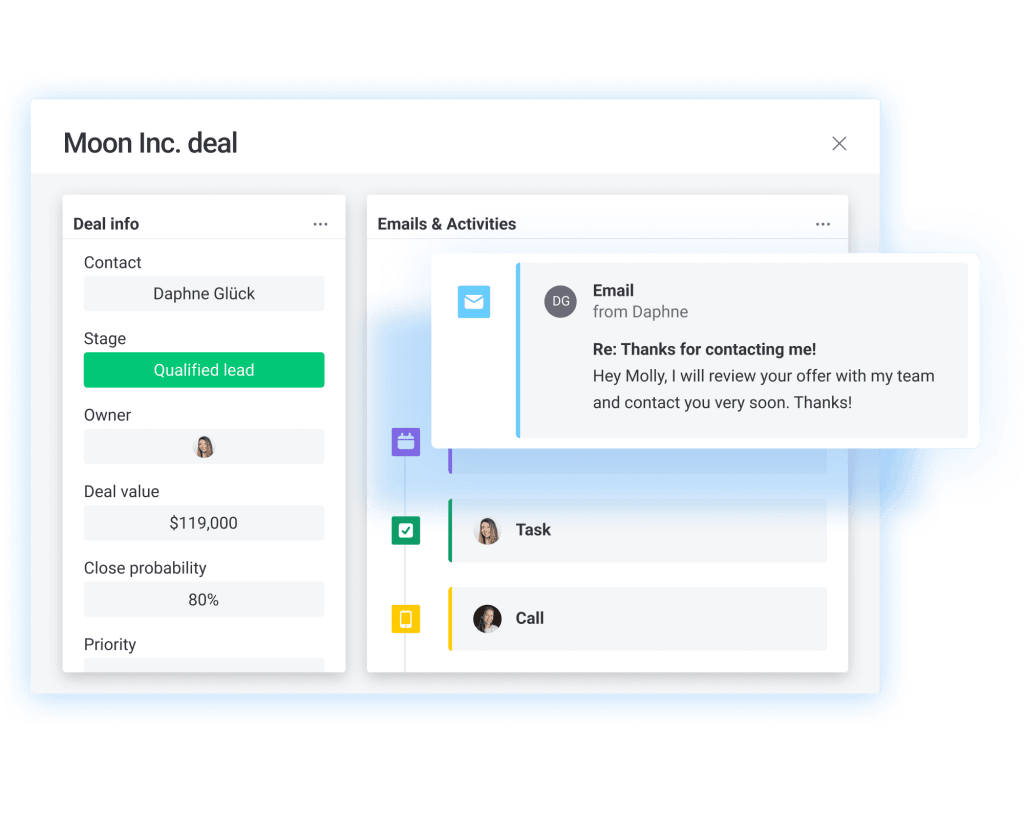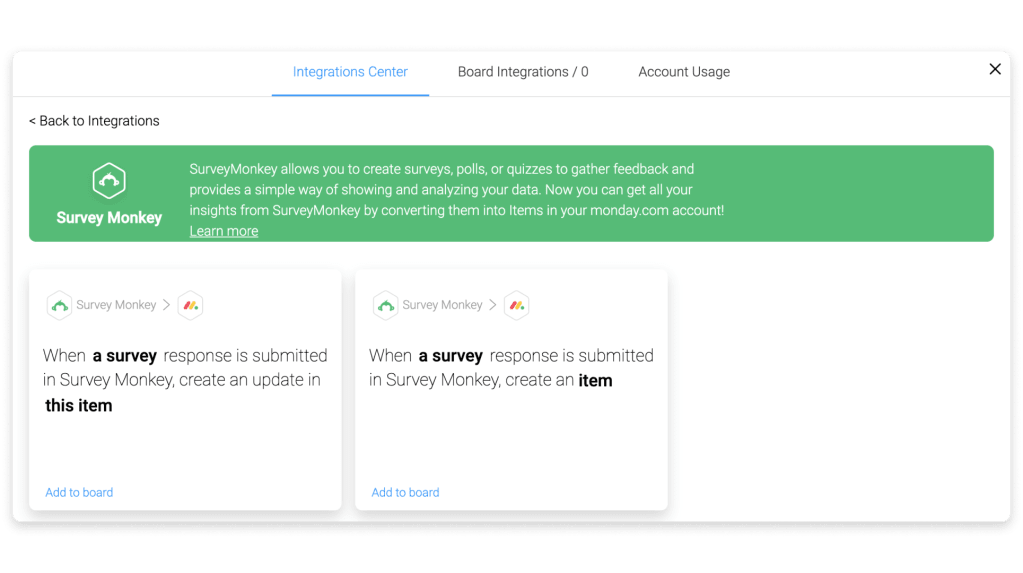If you’ve ever found yourself uttering something along the lines of “I could never live without my iPhone,” or “life would be so much harder without Amazon Prime,” then that’s the concept of customer obsession at work.
Customer obsession plays on our emotions as consumers in order to make us feel attached to a certain brand, service, or product. This attachment can come from different aspects of a brand, such as how it promptly replies to service requests or creates products that make your life easier.
In this article, we’ll put customer obsession under the microscope and look at how well-known approach this concept so that you can successfully build a customer-obsessed culture, too. Plus, we’ll look at how the monday.com sales CRM can help you centralize and analyze customer information, so you can easily build on customer culture.
What is customer obsession?
Customer obsession is the philosophy that a company should be focused on delivering the best possible experience for its customers. This means going above and beyond to ensure customers are satisfied and become loyal fans.
Some people might confuse customer obsession with customer support. While a good customer service experience is essential to creating customer obsession, they’re not the same thing. Customer obsession touches several parts of a business. In order for brands to build customer obsession, all aspects of customer interactions, from marketing to product launches and customer support need to be focused on customers’ needs.
Read also: Customer support vs customer service
Brands that live and breathe customer obsession
To better understand how customer obsession works in action, let’s have a look at some popular brands that understand how to use customer obsession.
Amazon
Jeff Bezos, Amazon’s CEO, constantly mentioned customer success as one of the core company philosophies and guiding business principles. As a result, Amazon focuses on providing the best customer experience possible, from its intuitive website to fast delivery services.
Bezos often claimed that many businesses were too competitor-focused instead of customer-focused, meaning they would instead try and outdo their competitors instead of delighting and satisfying their customers.
“Even when they don’t yet know it, customers want something better, and your desire to delight customers will drive you to invent on their behalf,” says Bezos. Indeed, this philosophy has led Amazon to successful services like Amazon Prime, Alexa, and Kindle. None of these services were created as a response to competitors, but rather as a response to customers’ needs.
Apple
Apple took a similar approach to Amazon by creating products that fulfilled a need that customers themselves didn’t even know they had yet. However, unlike Amazon, Apple focused on creating an unforgettable customer experience rather than on products that filled a gap.
When it came to creating groundbreaking products like the iPod or iPhone, Steve Jobs was always adamant that “you’ve got to start with the customer experience and work backward for the technology.”
Steve Jobs’ obsession with improving the customer experience is, in his view, what makes customers so loyal to Apple.
Apple builds its products around a user-friendly interface and interconnected devices, both of which work together to create a positive customer experience and deepens brand loyalty.
Disney
Like Apple, Disney was also headed by a leader who was obsessed with the customer experience. Disney has created an immersive experience in its films and parks that are built to satisfy and delight.
When designing Disney World, Disney wanted to create an amusement park that was clean and pleasant to spend time in. To accomplish this, he studied amusement park patrons to see how long they’d walk with trash in their hands. As it turns out, after about 30 feet, they would drop the trash. Walt used this information to ensure that there would always be trash cans within 30 feet of a visitor.
Small details like this are what sets Disney apart. When Disney fans offered feedback on a lack of diversity in its films, the company took those comments to heart and created films like Coco and Encanto to become a more inclusive brand.
Qualities that customer-obsessed brands share
Building a culture of customer obsession in your company isn’t so much about following specific steps, but rather adopting a set of qualities and mindsets centered around your customers. Developing these areas will help you build customer obsession.
1. Focused on customer feedback
Brands that are customer-obsessed use feedback as a source of data. Feedback can be used to customize products and services, optimize customer journeys, create customer-focused strategies, ensure customer loyalty and satisfaction, and build long-term relationships. Tools like monday.com allow you to create customer feedback forms and then track the data you received to implement real change.
2. Proactive problem solvers
Consumers aren’t going to search for a solution to a problem they don’t know they have. Customer-obsessed companies are able to consider what problems customers might have that they can help with. For example, consumers didn’t know they were missing out on a sleek MP3 player, but when Apple created the iPod, it became the solution to bringing your music with you on a user-friendly device.
3. Make customer retention a priority
Customer obsession and retention go hand-in-hand. Brands want to build customer obsession is to build a loyal core group of returning customers. According to the Pareto Principle, 80% of a company’s revenue comes from 20% of its customers. This doesn’t mean brands can ignore 80% of their customer base, but rather learning how to bring customer value to that 20% can help attract and retain more customers.
4. Continuously innovate
Brands that are proactive and value feedback are also likely to consider innovation an important part of their culture. Innovation helps you stay ahead of the competition by proactively creating new products and services. Additionally, customer feedback can inform the innovation process and ensure products and services are consistently delivering value.
How monday.com can help you build a customer-obsessed culture
Creating customer obsession takes time and steady effort. To remain consistent while you build up the qualities that make a customer-obsessed brand, it’s important to keep track of your progress in all areas of your business. A comprehensive CRM management and software tool like monday.com can help you do just that.
Gather feedback

Create surveys from monday.com to gather feedback and collect the information in an organized dashboard, where you can use the data to implement changes to your business.
Improve engagement

The monday.com sales CRM software provides you with one tool where teams across departments can collaborate on the customer experience as they move through the sales pipeline, gather customer information, and communicate with customers.
Integrate with existing tools

If you already have tools you’re using to run surveys, capture leads, or gather data, you can integrate them with monday.com to get all your information in one place. monday.com integrates with tools like SurveyMonkey, JotForm, HubSpot, and Eventbrite.
FAQ
Why is customer obsession important?
Customer obsession improves satisfaction and retention by helping you get closer to your customers, understanding their needs, building trust and loyalty, and creating products that meet their needs and wants.
How can you create a customer-obsessed culture?
There are a lot of directions you can take to create a culture of customer obsession, such as focusing on customer feedback, promoting customer-centric values, and making sure all employees put customer needs first.
What is the difference between customer focus and customer obsession?
Customer focus is when a company recognizes the importance of customer service and puts effort into providing a good experience. Customer obsession takes that a step further and is when a company takes a proactive approach to understanding customer needs and delivers solutions to address them.
Customer obsession breeds retention
Customer obsession might be time-consuming to establish, but the benefits of it are worth the extra effort. Building customer obsession won’t happen overnight, but with the right mindset and by employing tools like monday.com that keep all teams on the same page in regard to customer focus, you can create a loyal customer base.

